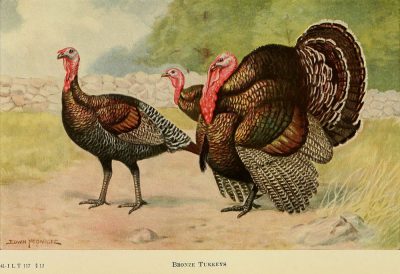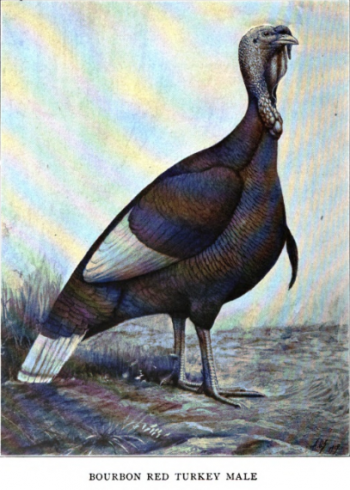Turkeys
| The Turkey | |||
|---|---|---|---|
| Origin | Category | Egg Colour | Sitter |
| America | Forest and Field | Speckled | Yes |

The Turkey is native to North and Central America. They have been used primarily as a table bird and are popular all around the world. In modern times a larger and meatier commercial turkey is primarily produced for the table and the historic domestic colour varieties are kept by poultry fanciers and hobbyists.
GENERAL CHARACTERISTICS

Head long, broad, and carunculated (covered with fleshy protuberances). Beak strong and curved. Eyes bold. Throat Wattle large and pendent.
Neck long and curved back towards the tail, the top and most of the front carunculated.
Body long, deep through the centre, and well rounded; broad and full breast; the cock's beard long, bristling, and prominent; somewhat curving back rising from the neck to the centre and descending in a graceful curve to the tail; large and powerful wings carried well up and closely to the side ; long and drooping tail, the end almost touching the ground.
Legs long. Shanks stout and strong. Toes straight and powerful.
Carriage stately and upright.
Plumage hard and glossy.
Weight Cock from 27 lb. to 36 lb. Hen from 18 lb. to 20 lb.
COLOUR VARIETIES
THE BLACK
Beak dark horn or slate-black. Eyes dark hazel. Head (including face, jaws, throat wattle, and caruncles) brilliant red, changeable to bluewhite. Legs and Feet dark lead or slate-black. Plumage lustrous black.
Disqualifications: Feathers other than black in any part of the plumage, a slight bronze tinge in back and tail not to disqualify.
| Weight | Weight | ||
|---|---|---|---|
| Adult Tom | 33 lb (15kg) | Adult Hen | 18 lb (3.63kg) |
| Yearling Tom | 30 (13.6kg) | Yearling Hen | 16 (7.26kg) |
| Young Tom | 23 (10.43kg) | Young Hen | 14 (6.35kg) |
THE BRONZE
Beak light horn at the tip and dark at the base. Eyes and Head as in the Black. Legs and Feet black, approaching brown in young birds, of a pink hue or flesh in adults.
Plumage of the Cock. Neck light brilliant bronze. Beard black. Back light brilliant bronze, each feather terminating in a narrow black band extending across the end. Breast dark brilliant bronze. Body black, shaded with bronze, but not as brilliant as that of the breast. Wings: bows black with a brilliant bronze or green lustre ; coverts rich bronze, the feathers terminating in a wide black band, and forming a broad bronze band across the wings when folded, and separated from the primaries by a glossy black ribbon-like mark formed by the ends of the coverts; primaries black or dark brown, pencilled across with bars of white or grey, the more evenly and regularly the better ; secondaries similar to the primaries, the colours changing to a bronze brown as the middle of the back is approached, but with little admixture of white ; an edging of white or brown on the primaries or secondaries is very objectionable. Tail dull black, each feather regularly pencilled with narrow bands of brown, ending in a broad black band with a wide edging of dull white or grey, the coverts dull black or dark brown, each feather regularly pencilled with narrow bands of brown, ending in a wide black and bronze band extending across the feather, with a wide edging of white or grey. (Note. The more distinct the colours throughout the whole plumage the better.)
Plumage of the Hen. Similar to that of the cock (but not as brilliant nor as clearly defined) except an edging of white on the feathers of the back, breast, body, and wing-bows, the edging to be narrow in front and to widen gradually as it approaches the rear.
THE WHITE

COLOUR OF MALE AND FEMALE
Head : Head (including face, jaws, throat wattle, and caruncles) brilliant red, changeable to bluish white. Beak : Light pinkish horn or flesh. Eyes : Dark Hazel. Throat-Wattles : Red, changeable to pinkish white. Shanks and Toes: Pinkish white. Plumage : Web, fluff, and quill of feathers in all sections, pure white, beard, deep black.
| Weight | Weight | ||
|---|---|---|---|
| Adult Tom | 33 lb (15kg) | Adult Hen | 18 lb (3.63kg) |
| Yearling Tom | 30 (13.6kg) | Yearling Hen | 16 (7.26kg) |
| Young Tom | 23 (10.43kg) | Young Hen | 14 (6.35kg) |
THE BLUE
Source of Blue standard required.
THE BOURBON RED
COLOUR OF MALE
Head : Red, changeable to bluish white. Beak : Light horn at tip, darker at base. Eyes: Dark Brown. Throat-Wattles : Red, changeable to bluish white. Neck : Rich, dark, chestnut mahogany. Beard: Black.
Wings : Fronts, bows, and coverts, rich dark chestnut mahogany; each feather having a very narrow edging of black ; primaries and secondaries, pure white. Back: Rich, dark chestnut mahogany ; each feather from point of shoulders to base of main tail, having a very narrow edging of black. Tail: Pure White, with a dimly outlined bar of soft red crossing each main tail feather near the end ; coverts deep brownish red. Breast: Rich dark chestnut mahogany, feathers having a very narrow edging of lustrous black. Body and Fluff: Body, deep, brownish red ; each feather edged with a very fine line of black; fluff, a lighter shade of brownish red.
Legs and Toes: Lower thighs, dark chestnut mahogany; shanks and toes, reddish pink in adults ; deep reddish horn in young.
Under-colour of all Sections: Red, shading a light salmon at base.
COLOUR OF FEMALE
Similar to that of male, except there is no black edging in any section. On the breast each feather has a narrow thread-like edging of white.
| Weight | Weight | ||
|---|---|---|---|
| Adult Tom | 33 lb (15kg) | Adult Hen | 18 lb (3.63kg) |
| Yearling Tom | 30 (13.6kg) | Yearling Hen | 16 (7.26kg) |
| Young Tom | 23 (10.43kg) | Young Hen | 14 (6.35kg) |
Disqualifications More than one-third any other colour than white showing in either primaries, secondaries, or main tail feathers.
THE BUFF
Source required for Buff standard.
THE NARRAGANSETT

COLOUR OF MALE
Head : Red, changeable to bluish white. Beak : Horn. Eyes: Brown. Throat-Wattles : Red, changeable to bluish White.
Neck : Unexposed part of feather black, the exposed surface of each feather steel grey approaching white, terminating in a narrow, black band across the feather; the band increasing in width as the back is approached.
Wings: Fronts and bows, light steel-gray ending in a narrow band of black; coverts, a light steel-gray, forming a beautiful broad steel-gray band across wings when folded, feathers terminating in a distinct black band, forming glossy, ribbon-like mark, which separates them from secondaries, primaries, each feather, throughout its entire length, alternately crossed with distinct, parallel black and white bars of equal width, running straight across feathers ; flight coverts, barred similar to primaries ; secondaries, alternately crossed with distinct parallel black and white bars, the black bar taking on a light steel-gray cast on the shorter top secondaries, the white bar becoming less distinct; an edging of brown in secondaries being very objectionable.
Back: Rich, metallic black free from bronze cast; saddle, black, each feather ending in a broad, steel-gray band approaching white, the light band increasing in width as the tail-coverts are approached.
Tail: Main tail dull black, each feather regularly penciled with parallel lines of tan, ending in a broad band of metallic black, free from bronze cast, edged with steel-gray approaching white; coverts and lesser coverts, dull black, each feather regularly penciled with parallel lines of tan, having a wide band of metallic black, free from bronze cast, extending across it near the end, terminating in a wide edging of light steel-gray approaching white.
Breast: Unexposed part of each feather black, ending in a broad, light steel-grey band which becomes darker as the underbody is approached; each feather ending with a distinct black band, narrow at the throat and becoming wider at lower breast.
Body and Fluff: Body, feathers dull black, ending with a distinct wide band of white. Fluff, black, terminating in white. Undercolour in all sections very dark slate.
Legs and Toes: Lower thigh intense black edged with light steel grey. Shanks and toes in mature specimens deep salmon; in young specimens dark approaching salmon.
COLOUR OF FEMALE
Similar to that of the male in all sections except that the plumage on back should end with a distinct white edging of medium width; the black edging terminating at cape, and breast gradually changing to a white edging, which gradually widens as it approaches the rear.
Disqualifications Wings showing one or more primary or secondary feathers clear black or brown, except key feathers in young birds, or absence of white or gray bars more than one-half of the length of primaries ; white or gray bars showing on main tail feathers beyond greater main tail coverts, except terminating wide edging of white. Entire absence of black bands on greater tail coverts.
| Weight | Weight | ||
|---|---|---|---|
| Adult Tom | 33 lb (15kg) | Adult Hen | 18 lb (3.63kg) |
| Yearling Tom | 30 (13.6kg) | Yearling Hen | 16 (7.26kg) |
| Young Tom | 23 (10.43kg) | Young Hen | 14 (6.35kg) |
THE ROYAL PALM
Source required for Royal Palm Standard.
THE SLATE
(Note: Check for difference between slate in US Standard here and slate in Australia.)
COLOUR OF MALE AND FEMALE
Head : Red, changeable to bluish white. Beak : Horn. Eyes : Dark brown. Throat-Wattles : Red, changeable to bluish white. Shanks and Toes: Pink in adults, deep pink in young. Plumage : Slaty blue ; beard, black.
| Weight | Weight | ||
|---|---|---|---|
| Adult Tom | 33 lb (15kg) | Adult Hen | 18 lb (3.63kg) |
| Yearling Tom | 30 (13.6kg) | Yearling Hen | 16 (7.26kg) |
| Young Tom | 23 (10.43kg) | Young Hen | 14 (6.35kg) |
Disqualifications
- Feathers other than slaty or ashy blue, which may be dotted with black, in any part of plumage.
STANDARD WEIGHTS
Where weights were available in public domain standards they have been inserted above in the relevant colour section.
Note that in the Australian Standards the weights of the various colours do vary with the Bronze and the White being very large, and the remaining colours being somewhat smaller.
SCALE OF POINTS
| Points | |
|---|---|
| Type | 30 |
| Colour | 25 |
| Weight | 25 |
| Head and Wattle | 10 |
| Legs and Feet | 5 |
| Condition | 5 |
| 100 |
SERIOUS DEFECTS
- Wry tail;
- Crooked breast bone;
- Any other deformity.
- In the Black, feathers of any other colour; cocks less than 20 lb., and hens less than 12 lb.
- In the Bronze, white feathers in any part, clear brown or black wings or minus white or grey bars more than one-half the length of the primaries, clear black, brown or grey back tail or tail-coverts ; cocks less than 30 lb., and hens less than 18 lb.
- In the White, any coloured feathers, other than white or pink-white legs; cocks less than 20 lb., and hens less than 12 lb.
SOURCES
- The Poultry club standards, containing a complete description of all the recognised varieties of fowls, ducks, geese and turkeys, ed. by William W. Broomhead. https://catalog.hathitrust.org/Record/009202629
- Extra information on turkeys can be found in 'Raising Turkeys' available for download at this link. https://www.biodiversitylibrary.org/bibliography/24191#/summary
- The American standard of perfection, illustrated. A complete description of recognized varieties of fowls, as revised by [the Association at its 62d-67th annual meetings, 1937-42.] https://catalog.hathitrust.org/Record/009169004
- The Australian Poultry Standards 2nd Edition.

